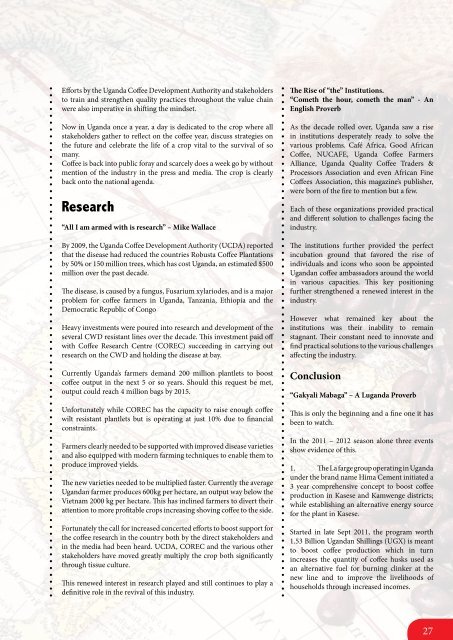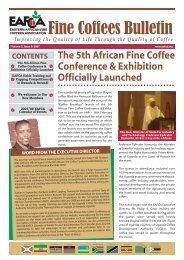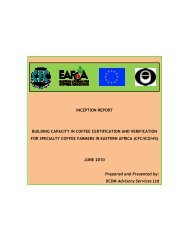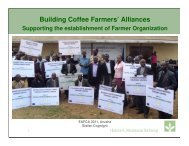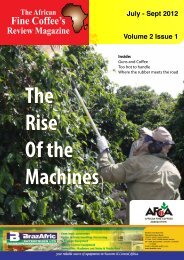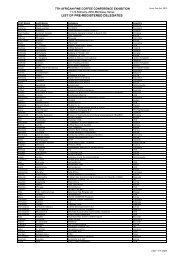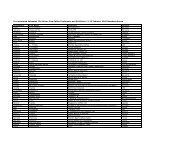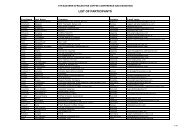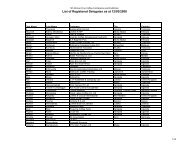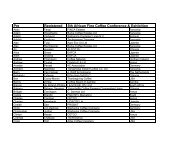African Fine Coffees Review Special Edition Oct-Dec - EAFCA
African Fine Coffees Review Special Edition Oct-Dec - EAFCA
African Fine Coffees Review Special Edition Oct-Dec - EAFCA
Create successful ePaper yourself
Turn your PDF publications into a flip-book with our unique Google optimized e-Paper software.
Efforts by the Uganda Coffee Development Authority and stakeholders<br />
to train and strengthen quality practices throughout the value chain<br />
were also imperative in shifting the mindset.<br />
Now in Uganda once a year, a day is dedicated to the crop where all<br />
stakeholders gather to reflect on the coffee year, discuss strategies on<br />
the future and celebrate the life of a crop vital to the survival of so<br />
many.<br />
Coffee is back into public foray and scarcely does a week go by without<br />
mention of the industry in the press and media. The crop is clearly<br />
back onto the national agenda.<br />
Research<br />
“All I am armed with is research” – Mike Wallace<br />
By 2009, the Uganda Coffee Development Authority (UCDA) reported<br />
that the disease had reduced the countries Robusta Coffee Plantations<br />
by 50% or 150 million trees, which has cost Uganda, an estimated $500<br />
million over the past decade.<br />
The disease, is caused by a fungus, Fusarium xylariodes, and is a major<br />
problem for coffee farmers in Uganda, Tanzania, Ethiopia and the<br />
Democratic Republic of Congo<br />
Heavy investments were poured into research and development of the<br />
several CWD resistant lines over the decade. This investment paid off<br />
with Coffee Research Centre (COREC) succeeding in carrying out<br />
research on the CWD and holding the disease at bay.<br />
Currently Uganda’s farmers demand 200 million plantlets to boost<br />
coffee output in the next 5 or so years. Should this request be met,<br />
output could reach 4 million bags by 2015.<br />
Unfortunately while COREC has the capacity to raise enough coffee<br />
wilt resistant plantlets but is operating at just 10% due to financial<br />
constraints.<br />
Farmers clearly needed to be supported with improved disease varieties<br />
and also equipped with modern farming techniques to enable them to<br />
produce improved yields.<br />
The new varieties needed to be multiplied faster. Currently the average<br />
Ugandan farmer produces 600kg per hectare, an output way below the<br />
Vietnam 2000 kg per hectare. This has inclined farmers to divert their<br />
attention to more profitable crops increasing shoving coffee to the side.<br />
Fortunately the call for increased concerted efforts to boost support for<br />
the coffee research in the country both by the direct stakeholders and<br />
in the media had been heard. UCDA, COREC and the various other<br />
stakeholders have moved greatly multiply the crop both significantly<br />
through tissue culture.<br />
This renewed interest in research played and still continues to play a<br />
definitive role in the revival of this industry.<br />
The Rise of “the” Institutions.<br />
“Cometh the hour, cometh the man” - An<br />
English Proverb<br />
As the decade rolled over, Uganda saw a rise<br />
in institutions desperately ready to solve the<br />
various problems. Café Africa, Good <strong>African</strong><br />
Coffee, NUCAFE, Uganda Coffee Farmers<br />
Alliance, Uganda Quality Coffee Traders &<br />
Processors Association and even <strong>African</strong> <strong>Fine</strong><br />
<strong>Coffees</strong> Association, this magazine’s publisher,<br />
were born of the fire to mention but a few.<br />
Each of these organizations provided practical<br />
and different solution to challenges facing the<br />
industry.<br />
The institutions further provided the perfect<br />
incubation ground that favored the rise of<br />
individuals and icons who soon be appointed<br />
Ugandan coffee ambassadors around the world<br />
in various capacities. This key positioning<br />
further strengthened a renewed interest in the<br />
industry.<br />
However what remained key about the<br />
institutions was their inability to remain<br />
stagnant. Their constant need to innovate and<br />
find practical solutions to the various challenges<br />
affecting the industry.<br />
Conclusion<br />
“Gakyali Mabaga” – A Luganda Proverb<br />
This is only the beginning and a fine one it has<br />
been to watch.<br />
In the 2011 – 2012 season alone three events<br />
show evidence of this.<br />
1. The La farge group operating in Uganda<br />
under the brand name Hima Cement initiated a<br />
3 year comprehensive concept to boost coffee<br />
production in Kasese and Kamwenge districts;<br />
while establishing an alternative energy source<br />
for the plant in Kasese.<br />
Started in late Sept 2011, the program worth<br />
1.53 Billion Ugandan Shillings (UGX) is meant<br />
to boost coffee production which in turn<br />
increases the quantity of coffee husks used as<br />
an alternative fuel for burning clinker at the<br />
new line and to improve the livelihoods of<br />
households through increased incomes.<br />
27


